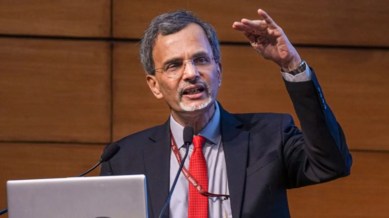Deregulation to be a big theme in upcoming Economic Survey: CEA V Anantha Nageswaran
The CEA also underlined that the growth forecast of 6.5-7 per cent for FY25 still looks “feasible”, stressing that a correction in wage structure for employees by the corporates is required to push consumption and savings growth.

Deregulation, or the process of letting go of regulations in some spheres, would be a big theme for the upcoming Economic Survey for 2024-25, which would be presented alongside the Budget for FY26 in February, Chief Economic Advisor V Anantha Nageswaran said on Thursday. The CEA also underlined that the growth forecast of 6.5-7 per cent for FY25 still looks “feasible”, stressing that a correction in wage structure for employees by the corporates is required to push consumption and savings growth.
Stating that there has been a “creeping informalisation” of the workforce after the COVID-19 pandemic, Nageswaran said more contractual employees have been hired than regular ones, and the wage growth of such corporate employees has not kept up pace with the rate of inflation, and that has exerted a “downward pressure” on consumption. “…if you want to have consumption being the driver of growth, then it is very clear that some of the shift in the hiring practices of the corporate sector does have to be looked up as a possible source. Post Covid there has been what I call a creeping informalisation of the workforce in the Indian corporate sector. Individually for every company it may be an optimal solution or logical solution. But, collectively it does exert a downward pressure on consumption,” he said at an event organised by industry chamber Assocham.
monthly limit of free stories.
with an Express account.
Citing wage growth data from a report by Quess Corp and Ficci, the CEA said the “annual average wage growth for contract employees in different sectors has not kept up with inflation”. This, he said, stands out in the context that profitability of companies has grown by 4X in the last four years in absolute terms and has hit a 15-year high as a share of GDP (Gross Domestic Product). He said if the country has to have a “secular growth in consumption”, then work has to be done to turn small and medium enterprises into medium and large enterprises; cost of capital has to become lower; and ensuring employment income growth and thus spending for growth. “Otherwise, it will become a mutually self-destructive cycle,” he said.
A “viable and vibrant” small and medium enterprises sector, human capital infrastructure and deregulation will be explored in the upcoming Economic Survey, he said. There is a necessity for the private sector to find the “right balance” between capital intensive and labour intensive growth, he said.
Nageswaran further said that for bridging both gender divide and job creation, policy can do more in terms of deregulation. “For example, the number of occupations that are restricted for women in different states, if you add them up, it comes to 118 restrictions. These occupations are deemed risky for women to participate, at a time when women are being fighter pilots and they are participating in defence, flying commercial airlines”
“So if you want to increase female labour force participation or employment more generally speaking, the focus has to be on the plumbing of deregulation that has to happen in state and local governance. We touched upon it quite a bit in the Economic Survey in July and that is going to be the big theme. Deregulation or letting go is the big theme for the coming Economic Survey as well,” Nageswaran said.
While stressing on the role that the MSMEs (micro, small and medium enterprises) need to play in raising manufacturing’s share in the country’s GDP to 25 per cent or more, Nageswaran said that India must learn from the successes of Germany and Switzerland in this context. He noted that some Indian enterprises choose to stay ‘micro’ in order to enjoy the concessions that come with staying under a certain threshold. “We must break the tyranny of concessions, if we are to grow,” he said.
On the overall economic growth front, Nageswaran said economic activity in some sectors has picked up pace during the first two months of the third quarter of October-December and the GDP growth of 6.5-7 per cent, as forecasted in the Economic Survey 2023-24, for the current financial year is feasible.
His remarks come after the latest GDP print released on November 29 showed that India’s growth slumped to a seven-quarter low of 5.4 per cent in July-September. The CEA said that the 5.4 per cent second quarter GDP growth estimate could be revised upwards going forward, as the current estimates are not seasonally adjusted.
“I think in reacting to these numbers, I don’t think we should throw the baby out with the bathwater. Because the underlying growth story still remains very much intact,” Nageswaran said.
He said the slowdown in GDP growth in the second quarter could be because of some “religious observances” in September and excess monsoon rainfall, and could be also because of other more long-standing issues that are beginning to emerge. So explanations could be from mundane to more serious ones, he said, adding this is the first estimate for the second quarter GDP growth. “It could be revised higher,” Nageswaran said.
He noted that to be able to hit 6.5 per cent growth for the year as a whole, the Indian economy would need to clock a 7 per cent real GDP growth in the next two quarters. “I think that it is doable if you look at some of these pickups that have happened in specific areas. So I believe that a growth outcome in the range of 6.5-7 per cent is feasible for the year,” he said.